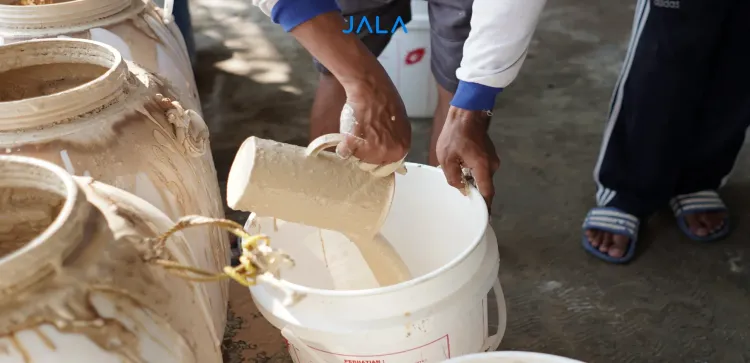
How to keep shrimps fresh?
As a perishable food product, shrimp quality is the most important factor to consider in order for shrimp to have a high economic value. There are several ways for maintaining the quality and freshness of the harvested shrimps. However, before maintaining shrimp quality, we need to understand the characteristics of shrimp that are declining in quality.
The characteristics of the decline in shrimp quality
Blackspot appearance on the shrimp skin
Blackspot or melanosis might form several hours after the shrimp has been harvested, especially if not treated immediately. Although blackspots are not dangerous for humans, they can affect consumer interest in purchasing the shrimps with it. Those shrimps might be regarded as unappealing.
Stingy smell
Freshly harvested shrimps typically have a fresh and fishy aroma. When the shrimp die, the metabolic process becomes uncontrollable, resulting in enzyme activity that tends to cause damage. Aside from enzymes, protein decomposition happens as a result of bacterial activity. The decomposition of these proteins will produce chemicals such as sulfur and ammonia, which emit a stingy smell. The longer this process goes on, the stronger the smell becomes.
Flaccid texture
Fresh shrimp meat is generally thick and elastic in texture. If the shrimps are not treated properly after being harvested, the texture of the shrimps will become flaccid. This is caused by protein decomposition in shrimp meat, which damages shrimp muscle tissue. Shrimp meat that has degraded in quality will usually release water and break easily when pressed. Furthermore, the color of the shrimp will turn pale reddish and slimy.
Successful tips in maintaining shrimp quality
What shrimp producers can do to maintain shrimp quality is to conduct a proper post-harvest management. Post-harvest management is generally conducted both during and after harvesting.
During harvesting
During the harvesting process, it is important to keep an eye out for any harm to the shrimps that may occur due to being trapped in the mud or caught in the net. Therefore, do not overfill the nets or sacks used so that the shrimp are not squashed and damaged. Similarly, clean and store harvested shrimps that have been exposed to mud separately from other shrimps.
After Harvesting
Shrimp quality begins to decline immediately after harvest. Therefore, shrimps should be stored at a low temperature as soon as possible to slow the deterioration of the shrimp flesh. This is often referred to as the cooling process. The cooling process can slow down the damage to the shrimps by suppressing the action of enzymes and bacteria after the shrimp dies, allowing the shrimps’ clear color, elastic texture, and fresh aroma to last longer. The washed shrimps are placed into ice water at -4°C before being stored. After sorting, the shrimps are stored in a container with bulk ice in a 1:1 ratio. Shrimps and ice are stacked in layers (ice-shrimps-ice-shrimps). Furthermore, the shrimps are shipped using a truck or pickup car equipped with fiberglass tanks. This fiberglass tub has been iced so that the shrimps’ temperature can be lowered to a maximum of 5°C during shipping. That way, the shrimp will remain fresh until it reaches the hands of the consumers.
References
FAO. 2014. Better Management Practices (BMP) Budidaya Udang Vannamei (Litopenaeus vannamei), Tambak Semi Intensif dengan Instalasi Pengolahan Air Limbah. Taken from http://awsassets.wwf.or.id/downloads/bmp_budidaya_udang_vannamei_2014.pdf
Pan, C., Chen, S., Hao, S., & Yang, X. 2019. Effect of low-temperature preservation on quality changes of Pacific white shrimp, Litopenaeus vannamei: A review. Journal of the Science of Food and Agriculture. Journal of the Science of Food Agriculture 99 : 6121–6128.
Sipahutar, Y. H., Suryanto, M. R. S., Ramli, H. K., Pratama, R. B., & Irsyad, M. 2020. Laju melanosis udang vanamei (Litopenaeus vannamei) pada tambak intensif dan tambak tradisional di kabupaten Bulukumba, Sulawesi Selatan. Prosiding Simposium Nasional Kelautan Dan Perikanan (7). Taken from https://journal.unhas.ac.id/index.php/proceedingsimnaskp/article/view/10792
Zulfikar, R. 2016. Cara penanganan yang baik pengolahan produk hasil perikanan berupa udang. Jurnal Aplikasi Teknologi Pangan 5 (2) : 29-30.
About the author
Benedicta Sekar Larasati is an alumnus of the Aquaculture study program, Fisheries Department of UGM batch 2015. She was born in Sleman on May 6, 1997, and until now she hasn’t grown tired of living in Yogyakarta. The author continues to learn to develop herself through writing, especially on fisheries topics.





